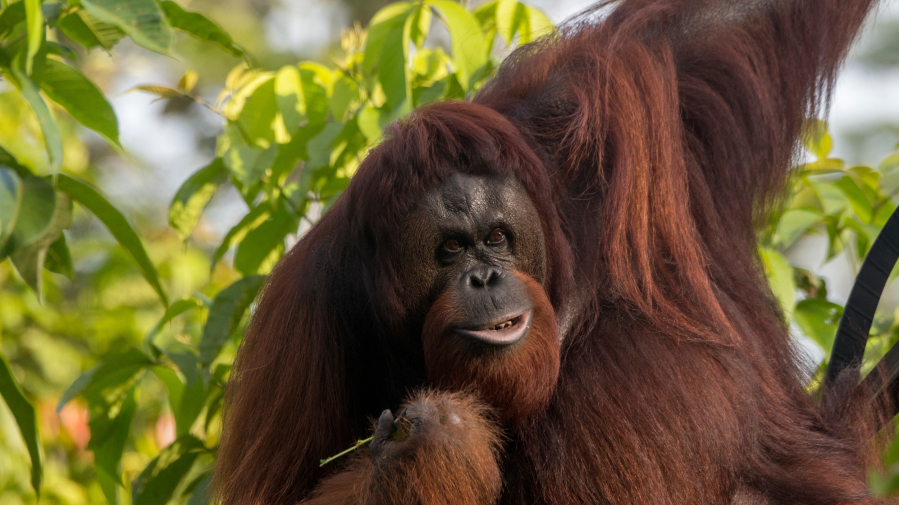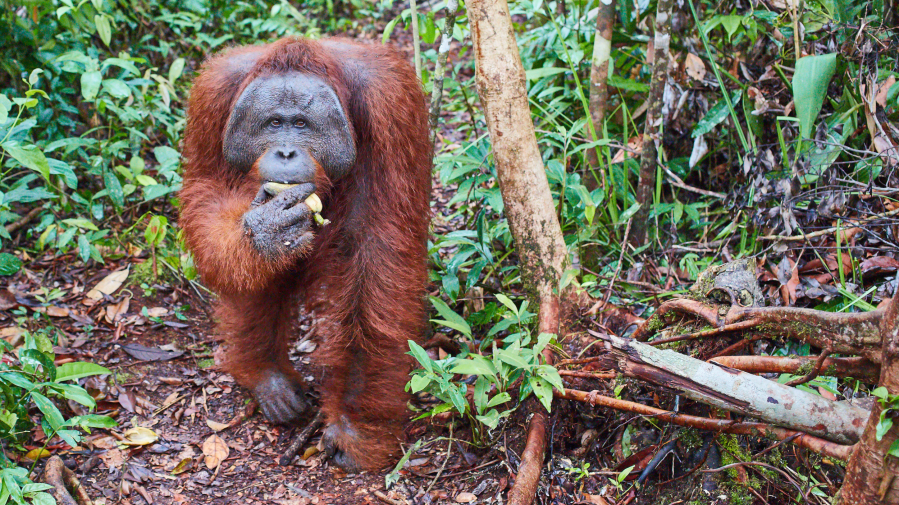All About Orangutan Conservation
These critically endangered primates play vital roles in maintaining the health of their home ecosystems.

Native to Sumantra and Borneo, the orangutan is the largest arboreal (tree-dwelling) mammal on Earth. They’re known for their shaggy, rust-colored hair and long arms, which enable them to swing from branch to branch for long periods in search of edible fruit, leaves and bark.
We humans share about 97% of our DNA with orangutans (they literally get their name from the Malay word for “person of the forest”). Research studies suggest that orangutans are the only non-human primates able to “talk” about the past and may be better at crafting tools than young human children.
Although the orangutan faces considerable threats and all three species are listed as critically endangered by the International Union for Conservation of Nature, they’re also one of the world’s most beloved animals. All over the world — even outside of their native range — orangutans are defended by conservationists and experts who work tirelessly to keep these primates in their habitat safe.
Read on to learn all about orangutan conservation, what makes them so special and what’s being done to tackle their greatest threats.
Where Are They Found?

Asia’s only great ape, orangutans are found only on the islands of Borneo and Sumatra, with their rainforest habitats located in both the Indonesian and Malaysian divisions. Adult males boast an impressive arm length of up to seven feet from fingertip to fingertip (longer than their standing heights, even). In the wild, they typically live between 30 and 40 years.
Orangutan Species
In the 1990s, all orangutans were considered part of a single species. In the early 2000s, however, taxonomic reviews showed that what was previously believed to be two subspecies living in Sumatra and Borneo were actually separate species. Later, in 2017, an isolated population of orangutans living in Batang Toru forest in Tapanuli, Sumatra was also confirmed as a new species.
According to the World Wildlife Fund about 104,700 Bornean, 13,846 Sumatran and 800 Tapanuli orangutans are left in the world today. A century ago there were an estimated 230,000 orangutans in total — so the global population appears to be decreasing.
How Strong Is an Orangutan?
Science suggests that orangutans and other apes have similar muscle strength to chimpanzees, exceeding human muscle by about 1.35 times. Studies have also discovered that orangutans have significantly larger monoarticular elbow flexor muscles and stronger rotator cuff muscles than chimpanzees, due perhaps to the greater amount of time spent swinging from trees rather than traveling on the ground.
Orangutans also have a powerful bite force — field observations among Bornean orangutans show that the animals consumed an average of 120 Annonaceae seeds per day using a jaw strength equal to the weight of six people.

Eating a Plant Based Diet
Fruit plays a primary role in the orangutan diet — studies have found that wild Sumantran orangutans in the Batang Serangan province spend up to 68% of their time feeding on fruits during certain times of the year. They also feed on bark, leaves, insects and flowers when fruit is scarce. Occasionally, orangutans are also observed eating bird eggs and small mammals. Some orangutan favorites include lychees, mangos, durians and figs.
Orangutan and Their Young
Orangutan mothers stay in close contact with their young for up to nine years — longer than almost all other mammals besides humans. One of the only members of the animal kingdom who perform active teaching, orangutan mothers tailor their behavior to match both the age and abilities of their young while they forage for fruit, which helps the baby orangutan learn new skills.
How They Contribute to Biodiversity
All that time spent foraging for seeds and fruits provides more than just nutritional value. The process plays a vital part in seed dispersal within their habitats — which is why orangutans are known affectionately as “gardeners” of the forest.
As they move throughout the forest, crushing hard seeds with their molars and bending branches to bring food to their mouths, they’re also helping to shape and maintain the health of the entire ecosystem. Orangutan diets are incredibly diverse and they feed on 453 different plants — over twice as many as other great apes.

Why Is the Orangutan Endangered?
Orangutan survival is severely threatened by habitat loss and fragmentation, especially as forests continue to be cleared for palm oil plantations, illegal and legal timber production and road development. Building roads through orangutan habitats can separate breeding populations, create more opportunities for further encroachment and leave animals more exposed to wildlife poachers. From 1999 to 2015, Borneo lost around half of its entire orangutan population — about 100,000 — from a combination of logging, land clearing and human conflict.
Bornean and Sumatran orangutans are also killed deliberately and illegally in human-wildlife conflict situations, such as when individuals raid fruit crops on farmland on the edge of forests. Even worse, surviving young are often taken for the illegal pet trade. In Kalimantan (the Indonesian part of Borneo), several thousand orangutans are killed every year for meat consumption and conflict mitigation.
Because of their low reproductive rate, orangutan populations take a long time to recover from declines. A female will only give birth to one infant every three to five years; gestation can take between seven and nine months. Paired with the long period of dependence on the mother, one breeding female will typically have just four or five babies within their lifetime.
What Conservationists Are Doing

All orangutans are protected under Appendix I of Cites — meaning international trade in specimens of these species is prohibited, except for the purpose of scientific research. Although orangutans are safeguarded by law in Malaysia and Indonesia, their forest habitats aren’t always protected. In fact, about 20% of wild Bornean orangutan habitat in Sabah (the Malaysian part of Borneo) and 80% in Kalimantan (the Indonesian part of Borneo) is not protected. The future of these animals is very much dependent on securing large stretches of protected forests where illegal logging and hunting are controlled.
As such, much of the conservation work surrounding orangutans involves preserving habitats and promoting sustainable forestry and agriculture. In 2015, the World Wildlife Fund Indonesia secured management of a 100,000 acres forest bordering Bukit Tigapuluh National Park in eastern Sumatra that had been initially designated for logging concessions. Known as Thirty Hills, it is one of the last places on the planet where elephants, tigers and orangutans coexist in the wild.
Orangutan Foundation International established Kalimantan’s first orangutan rehabilitation and release program at Tanjung Puting Reserve (now National Park) in 1971. Since then, they’ve added ongoing forest patrols and ecotourism programs that have been instrumental in preserving orangutan habitat from logging and encroachment — all while generating revenue for local communities.
The organization also runs educational programs about orangutans and forest conservation, including a sustainable forest production training program for the managing level staff of Indonesia’s largest palm oil company. Their wild orangutan research program is one of history’s longest-running continuous studies of any wild animal population.

The Leuser Ecosystem, a 26,000 square kilometer, mostly-contiguous forest in Indonesia, supports 95% of the world’s remaining Sumatran orangutans. In 2015, Global Conservation secured a $26 million fine against a major palm oil company that destroyed one of the last major peat swamp habitats for endangered orangutans. The fine resulted in three of the biggest buyers of palm oil from the Leuser Ecosystem region adopting policies that commit to halting destructive bulldozing in their supply chains. The nonprofit also provides wildlife protection training, SMART equipment, rations and technical support to local anti-poaching and illegal logging rangers.
Anti-poaching efforts and blocking the wildlife pet trade are also essential to orangutan conservation. Organizations like TRAFFIC help monitor the illegal wildlife trade and work with local governments to enforce restrictions on animal parts.
In 2020, the Orangutan Project joined the Orangutan Information Center and the Center for Orangutan Protection to launch an initiative called the Sumatran Rescue Alliance; The collaboration became an ongoing initiative to support the rescue, rehabilitation and repatriation of orangutans confiscated from the global wildlife trade.
How Individuals Can Help
Individuals can donate to one of the nonprofit organizations focused on orangutans, such as Orangutan Foundation International — many of which have symbolic “fostering” or “adoption” programs that go towards a range of conservation projects. Consumers can also avoid or limit products containing palm oil, the leading cause of deforestation in Sumatra and Borneo.





